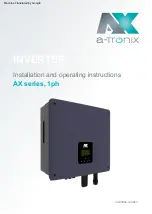
3
Operating Considerations
The TIA-952 is comprised of a
fi
ber coupled detector and two ampli
fi
er stages. The
fi
rst ampli
fi
er is a
transimpedance stage which converts the detector output current to a voltage by passing it through a
resistor of 500 ohms. Additional ampli
fi
cation is optionally provided by the second stage which also
serves to provide 50 ohm drive capability. The ampli
fi
ers are AC coupled.
The overall bandwidth of the unit is determined by the second stage gain setting. The bandwidth is in
excess of 800 MHz when the second stage is set for a gain of 1 and 300 MHz when it is set to a gain
of 5. The overall responsivity of the unit in terms of Volts/Watt is the current responsivity of the detec-
tor multiplied by the transimpedance and further multiplied by the second stage gain. For example,
the sensitivity of the unit at a wavelength of 1550 nm would be 0.9 A/W x 500 V/A x 5 = 2,250 V/W.
When using the TIA-952 mounted on an oscilloscope, the scope should have its input impedance set
to 50 ohms. If driving a coaxial cable, the cable should have a 50 ohm characteristic impedance and
be terminated with a 50 ohm load.
Spectral Response
The approximate relative response curves of the detectors employed is as shown below. Note that
these are representative curves and do not necessarily correspond to the exact response of the par-
ticular detector in use.
The approximate power at the detector surface is given by:
TIA 952 InGaAs Detector
TIA 952 Silicon Detector
Input power in watts (InGaAs)
Input power in watts (Si)
Peak output voltage (no load)
0.55 A/W x T
R
x % Relative response from graph/100
Peak output voltage (no load)
0.8 A/W x T
R
x % Relative response from graph/100
=
=

























